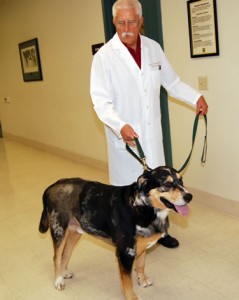 Kenny Rost isn’t certain of Angelo’s breed. He thinks the dog he adopted five years ago from the Jefferson City Animal Shelter is a mix of German shepherd dog, Australian heeler and Labrador. What is certain — he’s no cattle dog.
Kenny Rost isn’t certain of Angelo’s breed. He thinks the dog he adopted five years ago from the Jefferson City Animal Shelter is a mix of German shepherd dog, Australian heeler and Labrador. What is certain — he’s no cattle dog.
“He thinks he can work cattle, but he’s not very good at it,” Rost laughs. Despite his lack of herding skills, Angelo is the cattle farmer’s constant companion. “He goes everywhere I go. We have 257 acres, and he has the run of the place.”
Angelo was tearing around Rost’s Chamois-area farm one Sunday afternoon last summer when a truck suddenly turned from the highway that runs along the property into the driveway, surprising the dog who failed to move out of the way. The accident left Angelo with a shattered tibia in one of his hind legs. Rost took Angelo to a veterinarian in Hermann who, after reviewing radiographs of the dog’s injured leg, recommended taking him to the MU Veterinary Health Center in Columbia.
At MU, James Tomlinson, DVM, MVSci, examined Angelo and determined the dog’s injury made him a good candidate for a technique known as minimally invasive osteosynthesis fracture fixation. Tomlinson, a professor of small animal orthopaedic surgery, began developing minimally invasive techniques for orthopaedic surgery in canines about 10 years ago. The MU Veterinary Health Center is one of only a few places where the procedures are offered.
Tomlinson said that in injuries such as Angelo’s comminuted fracture, where the bone is splintered or crushed, he does not attempt to put the bone pieces back exactly in place.
“Among the advantages of using this procedure is we are not disturbing the pieces of the fractured bone, which means we are less likely to destroy the blood supply to the bone. The blood supply is needed for healing,” Tomlinson explained.
To repair Angelo’s shattered bone, Tomlinson used an I-Loc Interlocking Nail fixator designed by Dr. Loïc M. Déjardin of Michigan State University and manufactured by BioMedtrix to be specific to veterinary patients. The procedure involved inserting a locking nail system into Angelo’s tibia using a small incision rather than opening up the skin along the injured bone. Minimally invasive orthopaedic repairs are common in human medicine. Tomlinson can offer them to veterinary patients at the VHC because of the availability of an intraoperative fluoroscopy — a type of intraoperative X-ray machine. The intraoperative fluoroscopy allows for real-time imaging during the surgery, which makes it possible for Tomlinson to precisely implant the nail within the fractured bone.
The I-Loc fixator is primarily used in fractures of long bones, such as the tibia and femur. Tomlinson also on occasion uses a device consisting of locking plates developed by Synthes for injured bones that have sustained long fractures. The surgical procedure involves using an instrument to create a tunnel under the animal’s skin and then sliding a plate into the tunnel alongside the bone. The plate is then secured in place with locking head screw that locks into place. The plate and screw stabilize the bone until it has healed, a process that usually takes six weeks. Tomlinson first used the locking plate procedure in 2005 and is one of only a small number of veterinary orthopaedic surgeons currently offering the minimally invasive process in small animals.
The I-Loc fixator is used for medium to large dogs due to the size of nails that are available. However, the locking plates can be used on dogs of any size, as well as cats. Tomlinson said he also performs minimally invasive techniques for other types of bone injury, such as fractures of the condyle, or rounded portion, of the elbow and dislocations of the sacroiliac joint in the pelvis.
The advantages of the minimally invasive procedures are less pain for the injured animal, a decreased infection risk, and faster recovery. The procedures are no more costly than conventional orthopaedic surgery. In fact, Tomlinson said, the interlocking nail system is potentially less expensive due to the speed with which he can implant the device means less time is spent under anesthesia.
Rost said he was amazed by Angelo’s recovery following his surgery. “After a week or two, we couldn’t believe how well he was doing. It was about eight weeks from the accident to him getting the go-ahead to do whatever he wants. Now, you wouldn’t know anything had happened to him.”



